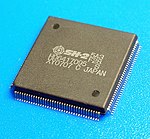SuperH
SuperH ( SH ) is a RISC -like processor architecture . It was originally developed by Hitachi . Development was later continued by a joint venture between Hitachi and STMicroelectronics , SuperH Inc. Since the merger of Hitachi's semiconductor business with Mitsubishi Electric, Renesas Electronics has continued SuperH .
The architecture is very widespread in Japan and is used worldwide in many embedded systems, especially in automotive applications. It uses very little electricity and is relatively inexpensive. HP's Jornada series is based on SH processors.
There are five generations in total to date.
SH-1
The SH-1 is a classic 32-bit processor with a maximum clock of 20 MHz. This version was used as a coprocessor in Sega's game console Saturn and u. a. used in the ELSA TanGo 1000 ISDN adapter and in the ELSA Microlink 56k Internet II analog modem . There was no further marketing or licensing.
SH-2
The SH-2 corresponds to a large extent to the SH-1, only that the SH-2 CPU was clocked with up to 28.7 MHz. It was used as the main processor in the Sega Saturn . A clocked at 23 MHz version came in Sega 32X - hardware extension used. No further marketing or licensing took place here either. The SH-2 was also used on the Kaneko Super Nova System and Psikyo SH2 arcade boards . A well-known game is e.g. B. Strikers 1945 II from Psikyo, which was implemented for the PlayStation and the Sega Saturn , among others .
In embedded systems, inexpensive SH-2 series controllers are still used today, especially in the automotive sector for engine control.
A further development of the SH-2 core is the SH-2A core, which is clocked quickly up to 200 MHz and is mainly used today in the automotive and mobile communications sectors.
SH-3
Like their predecessors, the SH-3 is also a 32-bit CPU, which was clocked at up to 200 MHz and a memory management unit (Engl .: Memory Management Unit contains MMU). A special form of the SH-3 is the SH3-DSP, also known as the SHmobile. This form is mainly used in cell phones. This line is still being developed and sold by Renesas Technology today . The SH3-DSP is also used as a digital signal processor in the music sector, for example in the Electribe MX from KORG .
SH-4
The SH-4 is a 32-bit microprocessor (64-bit when using double-precision micro-instructions ) with an integrated 128-bit FPU (floating point unit), which is supplemented by a vector unit ( VPU ). The performance amounts to around 360 MIPS (million instructions per second), the floating point unit delivers 1.4 billion floating point operations per second (Giga- FLOPS , or GFLOPs for short). The RISC processor clocked at around 200 MHz served as the CPU in the Sega Dreamcast video game console , the successor to the Sega Saturn . Like its predecessor, the SH-4 is also widespread in the automotive industry. For example, an SH-4 clocked at 400 MHz is used in the Audio 50 APS head unit of the Mercedes-Benz C-Class W204 and a version clocked at 600 MHz is used in the APS-50 of the E-Class W212 (from 2009). BMW also began to use the SH-4 as an application processor in their head units from 2004, where it was first used in the 5-series E60 and later found its way into the following models.
SH-5
SH-5 is the first 64-bit CPU in the SuperH line and contains a vector-capable 128-bit FPU.


